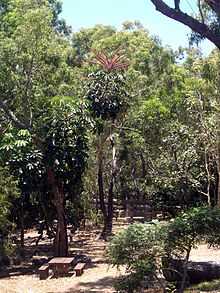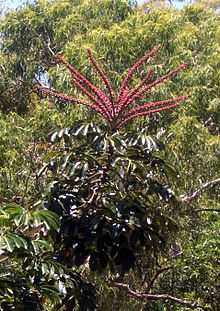Schefflera actinophylla
| Schefflera actinophylla | |
|---|---|
 | |
| Schefflera actinophylla in the Cooktown Botanic Gardens, Queensland | |
| Scientific classification | |
| Kingdom: | Plantae |
| (unranked): | Angiosperms |
| (unranked): | Eudicots |
| (unranked): | Asterids |
| Order: | Apiales |
| Family: | Araliaceae |
| Genus: | Schefflera |
| Species: | S. actinophylla |
| Binomial name | |
| Schefflera actinophylla (Endl.) Harms | |
| Synonyms | |
|
Brassaia actinophylla Endl.[1] | |

Schefflera actinophylla is a tree in the Araliaceae family. It is native to tropical rainforests and gallery forests in Australia (eastern Queensland and the Northern Territory), New Guinea and Java. Common names include Queensland umbrella tree, octopus tree and amate.
Description
_fruits_or_flowers_at_tree_canopy_at_Hyderabad%2C_AP_W_281.jpg)
S. actinophylla is an evergreen tree growing to 15 m (49 ft) tall. It has compound medium green leaves in groups of seven leaves. It is usually multi-trunked, and the flowers develop at the top of the tree. It often grows as an hemiepiphyte on other rainforest trees.[2] It produces racemes up to 2 m (6.5 ft) long containing up to 1,000 small dull red flowers. Flowering begins in early summer and typically continues for several months.
The specific epithet actinophylla means "with radiating leaves".[3]
Ecology
The up to 1,000 flowers produced by the plant generate large amounts of nectar, attracting honey-eating birds which then spread the seeds. The fruits are eaten by many birds and animals including musky rat-kangaroos, red-legged pademelons and spectacled flying foxes.[4] Its leaves are a favourite food of the Bennett's tree-kangaroo.[5][6][7]
Cultivation
Schefflera actinophylla is commonly grown in mild to warm climates as a decorative tree in larger gardens and, when mature, it has bright red spikes of flowers with up to 20 racemes which develop in summer or early autumn. Propagation is by seed or cuttings. It prefers well-drained soil and only needs occasional watering and feeding to thrive. It is, however, an aggressive plant and its roots can dominate surrounding soil. In some areas (e.g., Florida and Hawaii, USA) it is an invasive weed and therefore planting is highly unadvised.[8]
With a minimum temperature of 13 °C (55 °F), juvenile specimens are grown in temperate regions as houseplants.[9] This plant has gained the Royal Horticultural Society's Award of Garden Merit.[10]
Footnotes
- ↑ "Taxon: Schefflera actinophylla (Endl.) Harms". Germplasm Resources Information Network. United States Department of Agriculture. 2000-06-26. Retrieved 2013-07-24.
- ↑ Martin (2005), p. 43.
- ↑ Harrison, Lorraine (2012). RHS Latin for gardeners. United Kingdom: Mitchell Beazley. p. 224. ISBN 9781845337315.
- ↑ Beasley (2006).
- ↑ Pers. comm. Lewis Roberts OAM
- ↑ Martin (2005).
- ↑ Beasley (2009), p. 105.
- ↑ Hawaii's Most Invasive Horticultural Plants : octopus tree Schefflera actinophylla
- ↑ RHS A-Z encyclopedia of garden plants. United Kingdom: Dorling Kindersley. 2008. p. 1136. ISBN 1405332964.
- ↑ "RHS Plant Selector - Aruncus dioicus". Retrieved 03 June 2013.
References
- Beasley, John. (2006). Plants of Tropical North Queensland: The Compact Guide. Footloose Publications, Kuranda, Australia. ISBN 1-876617-13-6.
- Beasley, John. (2009). Plants of Cape York: The Compact Guide. John Beasley, Kuranda, Qld., Australia. ISBN 978-0-9806863-0-2.
- Martin, Roger. 2005. Tree-kangaroos of Australia and New Guinea. CSIRO Publishing, Collingwood, Vic., Australia. ISBN 0-643-09072-X.
External links
- Contains many images of Umbrella Tree
- Information about Schefflera actinophylla as an invasive weed in Hawaii
- Detailed description
Gallery
| Wikimedia Commons has media related to Schefflera actinophylla. |
| Wikispecies has information related to: Schefflera actinophylla |
-

Rainbow Lorikeets feeding on Umbrella Tree
-
_trunk_at_Hyderabad%2C_AP_W_286.jpg)
trunk in Hyderabad, India.
-
_leaves_at_Hyderabad%2C_AP_W_285.jpg)
leaves in Hyderabad, India.
-
_canopy_at_Hyderabad%2C_AP_W_281.jpg)
canopy in Hyderabad, India.
-
_at_Hyderabad%2C_AP_W_283.jpg)
in Hyderabad, India.